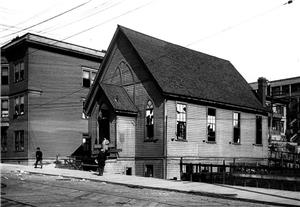The 13th article in HistoryLink's Turning Points series for The Seattle Times recaps the history of summer festivals from the first 1911 Potlatch though the creation of Seafair to help celebrate Seattle's centennial, up to Bumbershoot. The essay was written by Walt Crowley and published on August 3, 2001.
Summer in the City
The unfamiliar phenomenon of sunny weather has long perplexed Seattle residents. Do I wear a sweater? Do I take an umbrella? What exactly am I supposed to do, anyway?
Individuals and local communities were left to find their own solutions until July, 17, 1911, when Seattle celebrated its first citywide summer festival, the Golden Potlatch.
Originally conceived to celebrate the tenth anniversary of the 1897 Klondike Gold Rush, the first Potlatch was only four years late. It was also a few dollars short in the anthropology department, for the tribal gift exchange and assembly called Potlatch is a North Coast ritual not practiced by Seattle-area Salish. No one seemed to care, however, especially when the first festival’s parades, boat and auto races, and community fairs attracted 300,000 visitors.
Reds, Riots, and Bombing Raids
The second annual Potlatch festival was even more successful, but things turned ugly in 1913. That July, The Seattle Times was locked in a political duel with newly elected Seattle Mayor George Cotterill. Times publisher and editor Alden J. Blethen considered the engineer-reformer a dangerous radical because of his advocacy of prohibition and his tolerance rabble-rousing street speakers from the Industrial Workers of the World -- Wobblies -- and other socialist groups.
On July 18, the Times published what many viewed as inflammatory accounts of a patriotic speech at the Rainier Club by the secretary of the U.S. Navy and an unrelated scuffle between sailors and Wobblies. That night, enraged mobs ransacked the IWW and Socialist Party headquarters, along with a Skid Road mission mistaken for a nest of Reds. Mayor Cotterill blocked distribution of further editions of the Times until overruled by a local judge.
Calm was restored but the Potlatch was mortally wounded, and the onset of World War I the following June delivered the death blow. On July 17, a Times reporter went aloft with daredevil pilot Si Christofferson and dropped flour sack “bombs” on the downtown to demonstrate Seattle’s vulnerability to air attack. The Potlatch stunt did help to promote Sand Point’s development as a county airport and naval air station, but it didn’t exactly encourage a festive mood that summer.
Welcome Aboard, Seafair
Potlatch was briefly revived in the late 1930s and then suspended for World War II. With peace and relative prosperity restored by 1950, Seattle Mayor William Devin invited local business and community leaders to think about a new civic festival to help mark the city’s coming centennials in 1951 and 1952.
Among the participants were James Douglas, a co-founder of Northgate and son of the legendary downtown Metropolitan Tract manager. As he recalls in his memoir (excerpted on HistoryLink), "Obviously such an annual event would be largely built around the water since Seattle is so blessed with both fresh and salt water bodies. At the same time this subject was being pursued by the mayor's committee, there was a loosely knit organization of people involved in the marine industry who were trying to promote their industry of sailing and cruising. This organization was known as the Seattle Salts.”
Joining with a local booster group called Greater Seattle, Inc., Seafair planners donned some rented royal regalia a la New Orlean’s Mardi Gras and prepared to launch the first weeklong festival on August 11, 1950. Anticipation was boosted when Stan Sayres' revolutionary Seattle-built hydroplane Slo-Mo-Shun IV set a world speed record during Lake Washington trials that June and then left competitors in Detroit’s 1950 Gold Cup Race drenched in its rooster tail.
Don’t Forget Your Bumbershoot
When the hydro races moved to Seattle in 1951, most forgot that Seafair was supposed to be a birthday party for the city. The festival’s quaint blend of neighborhood hoopla, thunder boats, mock monarchs, beauty queens, cavorting clowns, vigilantes and pirates has somehow survived a half a century of fickle fashion and censorious politics.
Of course Seafair no longer enjoys a monopoly on outdoor festivities. The Century 21 Exposition established Seattle Center as a permanent locus for community-wide gatherings in 1962, and every neighborhood and most suburban cities have hosted spring or summer events at least since the first U District Street Fair was held in 1970 to sooth community tensions.
Bumbershoot now reigns the region’s largest single summertime assembly. The event began as a modest arts festival sponsored by Mayor Wes Uhlman in 1971, and soon diversified and expanded into a Labor Day extravaganza under the magic wand of One Reel.
The proliferation of our summer options is one measure of Seattle’s development over the past century and a half, but one question remains: should I take an umbrella?

